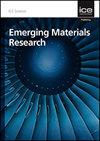利用Evans–Polanyi原理研究原始和Cu掺杂ZnO团簇与乙醇的反应机理
IF 1.2
4区 材料科学
Q4 MATERIALS SCIENCE, MULTIDISCIPLINARY
引用次数: 2
摘要
计算了乙醇(C2H6O)和其他几种气体的原始和Cu掺杂的ZnO纳米颗粒的相互作用和吸附。这些气体包括二氧化碳(CO2)、一氧化碳(CO)、氨(NH3)、臭氧(O3)、二氧化氮(NO2)和二氧化硫(SO2)。这些气体大多是空气污染物。ZnO纤锌团簇用于表示ZnO纳米颗粒。评价了反应的吉布斯自由能和焓。Evans–Polanyi原理用于评估活化能,该活化能最适合反应的Arrhenius方程。将反应速率方程的求解结果与实验结果进行了比较。包括气体在到达传感器表面之前与空气的反应。计算响应时间的比较(10.5 s) ,恢复时间(470 s) ,并进行具有可用实验结果的反应速率(9和420 分别为s) ppm的乙醇。从以上结果来看,Evans–Polanyi原理与Arrhenius方程相结合可以给出可接受的结果。响应时间与气体浓度成反比,而恢复时间与气体密度成线性比例。相关因子可以将反应速率与响应相关联。本文章由计算机程序翻译,如有差异,请以英文原文为准。
Reaction mechanisms of pristine and Cu-doped ZnO clusters with ethanol using Evans–Polanyi principle
The interaction and adsorption of pristine and Cu-doped ZnO nanoparticles of ethanol (C2H6O) and several other gases are calculated. These gases include carbon dioxide (CO2), carbon monoxide (CO), ammonia (NH3), ozone (O3), nitrogen dioxide (NO2), and sulfur dioxide (SO2). Most of these gases are air pollutants. ZnO wurtzoid clusters are used to represent ZnO nanoparticles. Gibbs free energy and enthalpy of reactions are evaluated. Evans–Polanyi principle is used to evaluate the activation energy that gives the best fit to the Arrhenius equation of the reaction. The results of solving the reaction rate equations are used to compare with experimental findings. The reaction of gases with the air before reaching the sensor surface is included. A comparison of calculated response time (10.5 s), recovery time (470 s), and reaction rate with available experimental results is performed (9 and 420 s respectively) for 50 ppm of ethanol at room temperature. From results above, Evans–Polanyi principle combined with Arrhenius equation can give acceptable results. The response time is inversely proportional to gas concentration, while recovery time is linearly proportional to the gas concentration. A correlation factor can relate reaction rate with the response.
求助全文
通过发布文献求助,成功后即可免费获取论文全文。
去求助
来源期刊

Emerging Materials Research
MATERIALS SCIENCE, MULTIDISCIPLINARY-
CiteScore
4.50
自引率
9.10%
发文量
62
期刊介绍:
Materials Research is constantly evolving and correlations between process, structure, properties and performance which are application specific require expert understanding at the macro-, micro- and nano-scale. The ability to intelligently manipulate material properties and tailor them for desired applications is of constant interest and challenge within universities, national labs and industry.
 求助内容:
求助内容: 应助结果提醒方式:
应助结果提醒方式:


